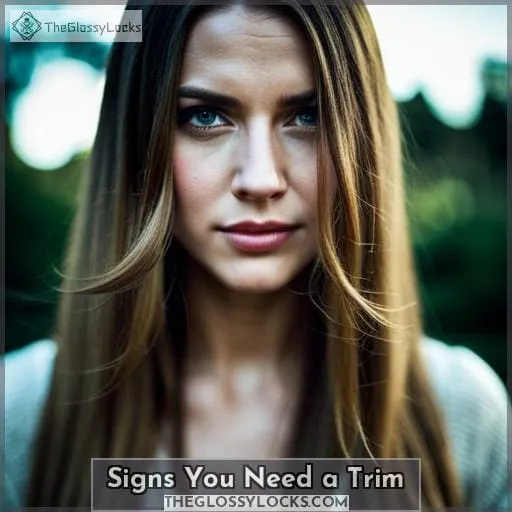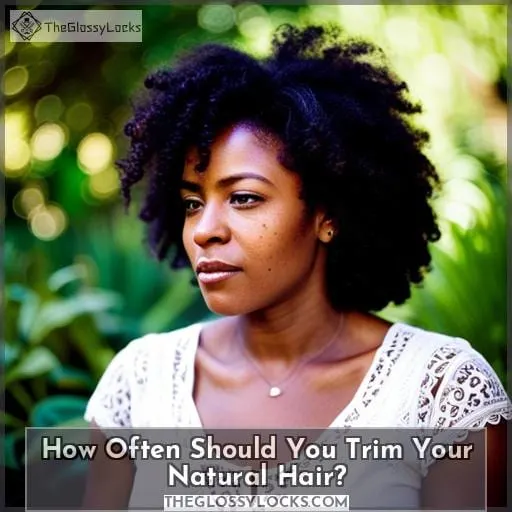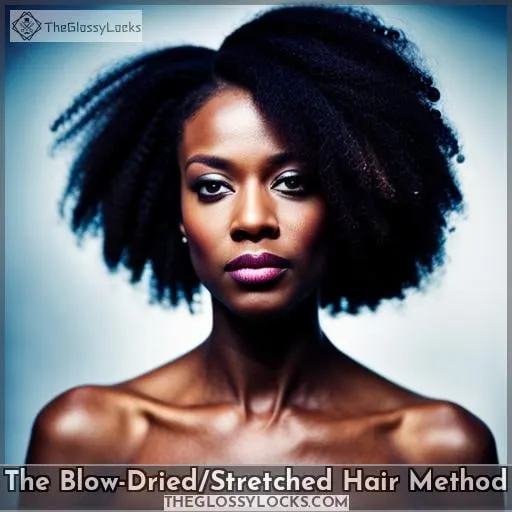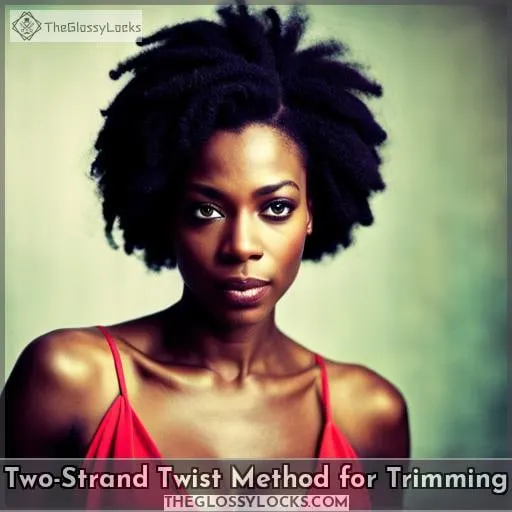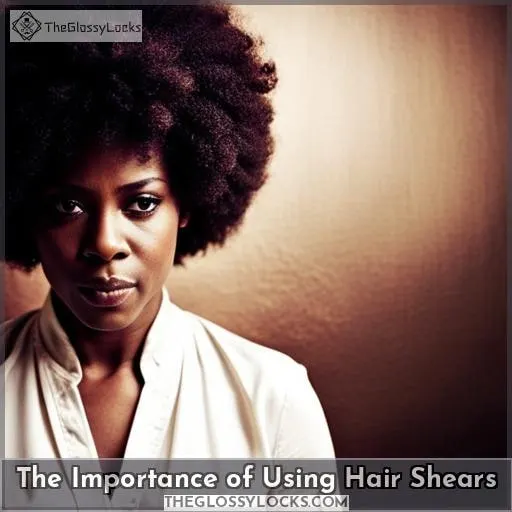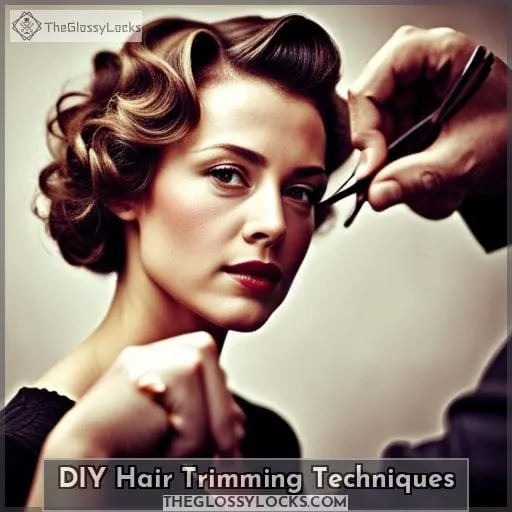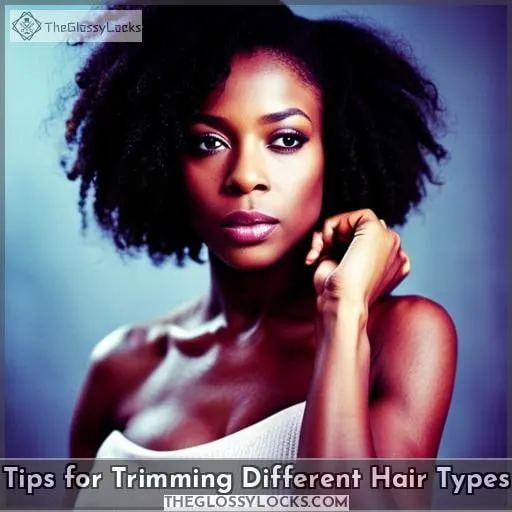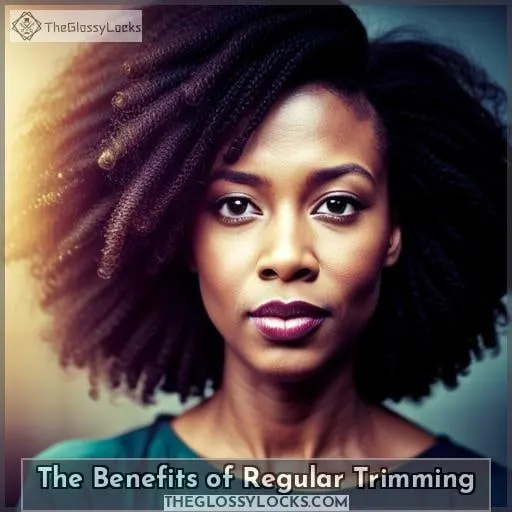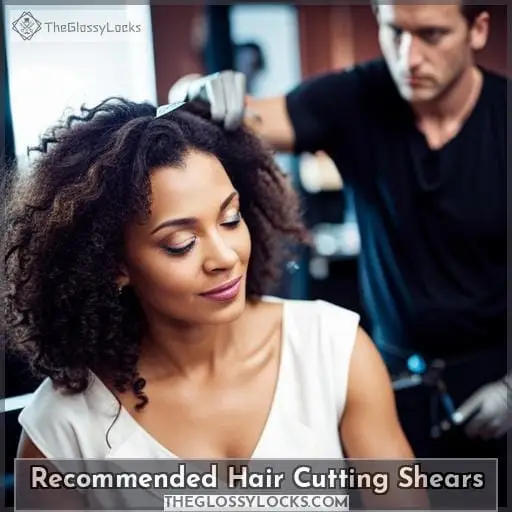This site is supported by our readers. We may earn a commission, at no cost to you, if you purchase through links.
 Ready to take your natural hair trimming into your own hands? You’ve come to the right place! Whether you’re looking for a new style or just want healthy and lengthy tresses, we’ll give you all the tips and tricks on how to properly trim natural hair.
Ready to take your natural hair trimming into your own hands? You’ve come to the right place! Whether you’re looking for a new style or just want healthy and lengthy tresses, we’ll give you all the tips and tricks on how to properly trim natural hair.
With regular trims, not only will you prevent split ends but retain length as well.
From signs that it’s time for a cut to DIY techniques like snipping twists or the search-and-destroy method – we have got everything covered so that when it comes time to pruning natural hair, you can do so with confidence knowing exactly what needs doing.
Understanding why regular trims are essential is key in maintaining healthy locks as they help keep moisture locked in while adding volume and bounce back into dull strands.
Table Of Contents
- Key Takeaways
- Signs You Need a Trim
- How Often Should You Trim Your Natural Hair?
- The Blow-Dried/Stretched Hair Method
- Two-Strand Twist Method for Trimming
- The Importance of Using Hair Shears
- DIY Hair Trimming Techniques
- Tips for Trimming Different Hair Types
- The Benefits of Regular Trimming
- Recommended Hair Cutting Shears
- Conclusion
Key Takeaways
- Trimming natural hair regularly helps prevent split ends and retain hair length.
- Using professional shears is important for precise cuts and maintaining the shears.
- DIY techniques such as snipping twists and the search-and-destroy method can be used for trimming.
- Choosing the right hair shears, such as stainless steel ones with an ergonomic design, is crucial for effective trimming.
Signs You Need a Trim
If your hair is constantly knotting, breaking, and feeling unmanageable, it’s time to give yourself a fresh start with a trim! Trimming techniques can range from blow-dried/stretched hair methods for precise cuts to two-strand twist methods for worry-free trims.
If you’re looking to save money on haircuts, try DIY tips such as investing in professional shears and learning how to section the hair properly. Healthy habits like regular trims every three months are essential for length retention and preventing split ends or single strand knots caused by excessive manipulation and heat damage.
Natural haircare products like Fresh Frozé Treatment Deep Conditioner can also help reduce frizzy ends that lead to breakage when combing or styling the hair.
How Often Should You Trim Your Natural Hair?
You might be wondering how often you should give yourself a trim to keep your locks looking fly—the answer is every three months! Regular trims help retain length and reduce breakage, while preventing split ends.
DIY hair trimming offers time and cost savings, but use professional shears for a clean cut instead of regular scissors. A blowout can provide better visibility for an even cut but requires caution to avoid damage.
Techniques such as snipping the ends of two-strand twists or stretching hair with a blow dryer before trimming are also helpful in achieving desired results without compromising on healthiness.
Quality shears don’t have to be expensive either; they can usually be found around $10 making them more accessible than salon visits or at home kits that promise quick fixes without quality assurance! Trimming natural hair regularly helps maintain healthy locks by promoting growth and shine while reducing tangles from split ends—it will make all the difference in keeping great looking curls throughout the year!
The Blow-Dried/Stretched Hair Method
Try the blow-dried/stretched hair method for precise cuts and to keep your ends looking healthy.
To do this, first use a wide-tooth comb to detangle your natural hair before it’s dry. Blow drying with low heat can help you achieve perfectly stretched strands, allowing you to trim away split ends accurately without risking excess length loss or creating jagged edges.
With precision in mind, follow up blow drying by sectioning off small parts of the hair using clips before snipping those sections with quality shears specifically made for cutting natural textures like coils or curls.
Regular scissors are not suitable for trimming because they will fray hairs and create uneven lines that lead to breakage over time when left untreated.
When utilizing heat protectants while blow drying, be sure that all products used are free from sulfates, which can strip moisture away from already fragile strands, leading them down an even more damaging path if not taken precaution against properly beforehand!
Visual trimming of knots is also recommended as opposed to cutting each section evenly since this approach helps maintain curl pattern during the process while providing better control over how much length removal takes place overall.
Two-Strand Twist Method for Trimming
Grab the shears and snip away split ends with the Two-Strand Twist Method for a no-fuss trim. The advantages of the two-strand twist are many: precision trimming, better control of how much length you remove at once, and great twist out results if done correctly.
This DIY method is an effective way to maintain healthy natural hair while minimizing breakage and preserving length retention. Start by sectioning your hair into smaller sections using clips or ties, depending on your preference.
Make sure the twists are equally sized so that they’re easy to work with when it comes time to cut them off.
Gently pull each twisted piece between your index finger and thumb until tight. Then, proceed to carefully cut each end as close as possible without causing damage. Be mindful that not all hairs will be even lengths! Keep in mind that this technique works best on curly/coily textures, as straightening may cause some of those tiny pieces you want trimmed off to go undetected due to their flatness against other strands.
Lastly, apply leave-in conditioner after the wash session to seal moisture back into the strands after being manipulated during the styling process.
The Importance of Using Hair Shears
Properly cutting your hair requires investing in a pair of quality shears, as regular scissors are not suitable for precise trimming. Choosing the right type of hairdressing shear is essential. Look out for stainless steel construction with an offset grip handle and razor-sharp blades.
Proper maintenance, including oiling the pivot section, will help keep them sharp and rust-free.
When it comes to natural hair trimming, experts recommend using specialized shears since they provide more control over uneven ends than general scissors do. This helps avoid excessive breakage or jagged edges after cutting methods like the search & destroy technique or two strand twist trims.
Additionally, purchasing professional-grade tools encourages healthier habits, which can ultimately lead to better length retention results over time!
DIY Hair Trimming Techniques
If you’re looking for a clean-cut trim to your natural hair, then snipping twists and using the search-and-destroy method are two techniques you should consider. Snipping two-strand twists is an easy way to get rid of dry and frizzy ends without taking off too much length.
The search and destroy technique involves identifying knots within your natural hair strands one by one before cutting them out with sharp shears. With these simple DIY methods, you can maintain healthy locks while avoiding expensive salon visits.
Snipping Twists for a Cleaner Twist-Out
Snip your twist-outs for a cleaner look! Achieving precision trimming while styling can be tricky, but two-strand twists make it easier. For frizz control and neat twist-out results, learn the following tips: 1) Maintain your twists by snipping off any straggling ends; 2) Watch haircare tutorials with detailed instructions; 3) Use DIY precision by using hair shears to ensure an even cut; 4) Control frizz by avoiding excessive manipulation of the strands.
Trimming Knots With the Search-and-Destroy Method
The search-and-destroy method is an effective way to reduce split ends and maintain clean hair – up to 75% of breakage can be prevented with regular trimming! To use this technique, spot knots and snip them off one by one.
This precision cutting helps keep your natural hair healthy while avoiding a drastic cut that could lead to length loss.
DIY trimming not only saves time and money but allows you complete control over the amount of length removed from textured hair. For those who want healthier, tangle-free locks, investing in quality shears is essential for precise cuts.
With proper maintenance through split end removal techniques such as search-and-destroy trims, having beautiful natural curls or coils has never been easier!
Tips for Trimming Different Hair Types
Trimming natural hair can be a daunting task, but it doesn’t have to be! With the right tools and techniques tailored to your specific hair type, you can easily maintain healthy locks at home. Whether you’re dealing with tight coils or loose curls, there are tips and tricks that will help make trimming your natural hair much easier.
Trimming Curl by Curl for Looser Curls
For looser curls (type 3A-3C), you’ll want to take your time and trim curl by curl for the best results. Clip each individual curl before snipping away what needs to be trimmed, ensuring not too much length is removed.
When using this precision technique, it’s important to apply Muhga Eltigani’s natural ingredient approach. She recommends using common kitchen ingredients like avocados, olive oil, and coconut for hair health.
Utilize online communities or YouTube videos for guidance. Ijeoma Kola’s demonstration on two strand twists can help you achieve a cleaner twist-out. Pay special attention when trimming frizzy dry ends in twists, as this helps retain length with minimal breakage.
Careful DIY trims can help maintain healthy looser curls while avoiding split ends.
Blowout for Better Visibility in Cutting
A blowout can provide superior visibility for an even cut, but it is time-consuming. Straightened hair makes trimming easier and can help you control the length of your haircut. When using heat to achieve a blowout, caution must be taken to avoid heat damage and breakage.
DIY techniques are cost-effective and allow precision when cutting natural hair at home; however, professional shears should always be used instead of regular scissors for clean cuts that won’t cause further split ends or tangles.
The Benefits of Regular Trimming
Regularly trimming your natural hair can have many benefits, including preventing split ends, retaining length, and improving overall health. Through regular trims, you’ll be able to maintain healthy-looking locks by reducing breakage and keeping your strands strong.
Preventing split ends
Regularly trimming your curls helps keep split ends at bay, allowing you to enjoy healthy, well-maintained hair. To prevent them, maintain moisture retention with protective styles. Use deep conditioners and avoid heat damage and excessive manipulation.
DIY hair trimming is an option that offers time and cost savings but requires caution when using shears. Dusting the ends every few weeks is recommended over snipping off inches of length all in one go.
Retaining hair length
By consistently trimming, you can maintain your desired length and keep breakage at bay. Investing in quality shears is important for precise cuts. Experts recommend trimming every 3 months to prevent split ends and retain hair growth.
DIY techniques like the search-and-destroy method or two-strand twist cut provide clean trims without sacrificing much length.
Improving hair health
Improving your hair health with regular trims is like sending your strands on a wellness retreat – it’s the ultimate boost for luscious locks. Trimming prevents breakage and helps retain moisture, keeping the scalp healthy and natural oils flowing.
Plus, protective styling ensures further damage prevention to keep those ends in check! Regular detangling with wide-tooth combs or search-and-destroy methods can be made easier by seeking help from an online community or watching tutorials by experts.
Recommended Hair Cutting Shears
For precise cuts, consider investing in ULG Professional Hair Cutting Shears to get the job done right. When choosing shears, it’s important to select a quality pair that will last and provide clean cuts.
Look for stainless steel blades with mirror-finish exteriors and an artificial sapphire set in the pivot section for added aesthetics.
The size of your shear should also be taken into account as well as its ergonomics. Look for scissors with shorter thumb handles if you have small hands or limited wrist mobility. Also, make sure they’re properly maintained by regularly oiling them so they retain their sharpness over time.
Quality shears can help you achieve the perfect trim each time without damaging your natural hair while saving money on costly salon visits!
Conclusion
As you’ve come to understand, regular trimming is an essential part of maintaining healthy and lengthy tresses. When it comes to trimming natural hair, there are a variety of methods, tools, and techniques to choose from.
Whether you opt for the blow-dried/stretched hair method, the two-strand twist method, or the search-and-destroy technique, you can ensure you get the best results with the right tools and knowledge.
Don’t forget to use quality hair shears for a precise cut. Regular trims help retain length, reduce split ends, and improve the overall health of your hair. So, why not take the time to learn how to trim your own natural hair and save time and money in the long run? With the right tools and techniques, you can have beautiful, healthy, and lengthy tresses.

